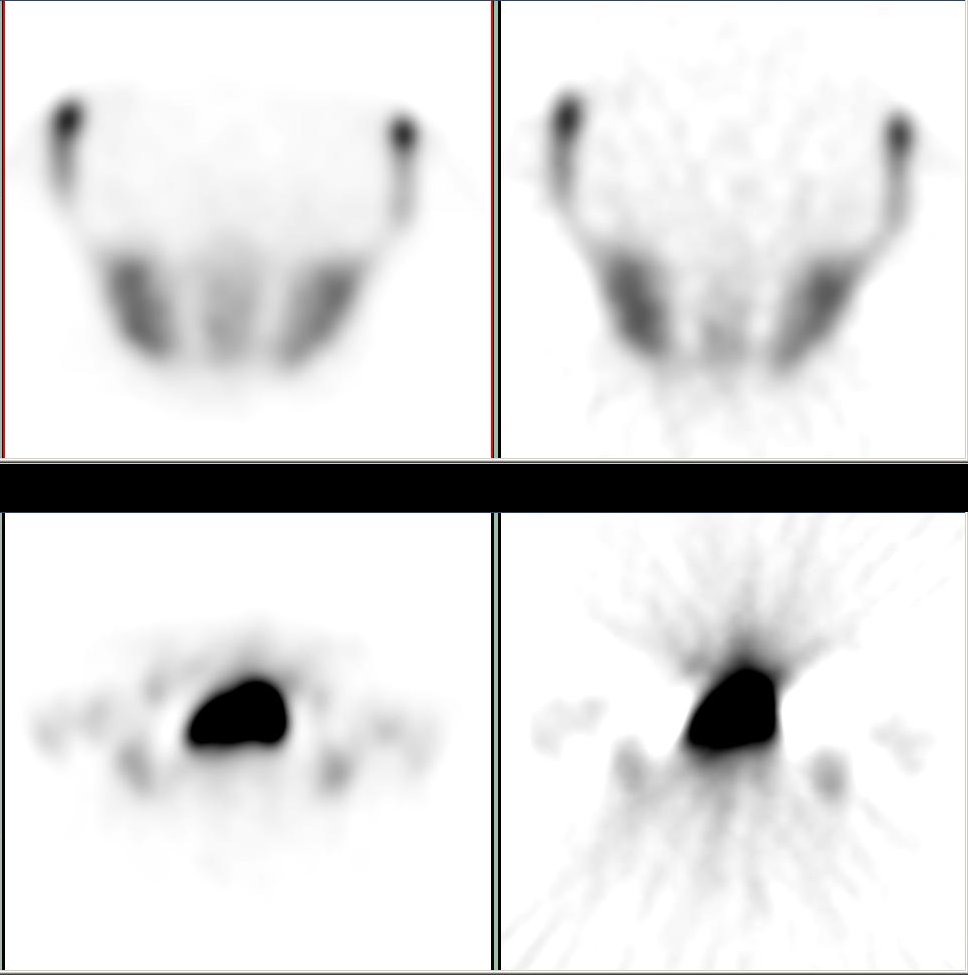|
Franz Pfeiffer (physicist)
Franz Pfeiffer (born 25 November 1972 in Kösching, Germany) is a German physicist known for his contributions to the development of Phase-contrast X-ray imaging and its applications in biomedical research. Research Pfeiffer contributed to the extension of known imaging modalities such as Differential interference contrast microscopy and Dark-field microscopy to the X-ray regime. In 2006 he demonstrated the feasibility of phase sensitive X-ray imaging with conventional, polychromatic X-ray sources and a grating interferometer. This enlarged the potential of X-ray phase imaging for clinical use as before the technique was only possible at synchrotron facilities. Pfeiffer further introduced the extraction of a supplementary signal (so-called "dark-field signal") sensitive to porous microstructure of a sample based on X-ray scattering. His research group at the Technical University Munich demonstrated a range of possible applications of the new modalities in medical and material ... [...More Info...] [...Related Items...] OR: [Wikipedia] [Google] [Baidu] |
Kösching
Kösching is a municipality in the district of Eichstätt in Bavaria in Germany. Personalities * Richard Scheringer (1904-1986), communist politician * Johanna Scheringer-Wright (born 1963) politician (The Left), member of the Landtag of Thuringia * Serkan Atak Serkan Atak (born 3 January 1984) is a Turkish footballer who plays as a winger. Raised in the youth ranks of FC Bayern Munich Fußball-Club Bayern München e. V. (FCB, ), also known as FC Bayern (), Bayern Munich, or simply Bayern, is ... (born 1984), German-Turkish footballer * Rudolf Winterstein (1920-2000), Heimatpfleger References Eichstätt (district) {{Eichstätt-geo-stub ... [...More Info...] [...Related Items...] OR: [Wikipedia] [Google] [Baidu] |
Polychromatic
Polychrome is the "practice of decorating architectural elements, sculpture, etc., in a variety of colors." The term is used to refer to certain styles of architecture, pottery or sculpture in multiple colors. Ancient Egypt Colossal statue of Tutankhamun Paris 2019 A.jpg, Polychrome quartzite colossal statue of Tutankhamun, 1355-1315 BC Nofretete Neues Museum.jpg, Polychrome limestone and plaster ''Bust of Nefertiti'', 1352–1336 BC Composite Papyrus Capital MET 10.177.2 EGDP018080.jpg, Polychrome sandstone Composite papyrus capital, 380–343 BC Medinet Habu 2016-03-23g.jpg, Polychrome winged sun on a cavetto from the Medinet Habu temple complex, unknown date Classical world Some very early polychrome pottery has been excavated on Minoan Crete such as at the Bronze Age site of Phaistos. In ancient Greece sculptures were painted in strong colors. The paint was frequently limited to parts depicting clothing, hair, and so on, with the skin left in the natural co ... [...More Info...] [...Related Items...] OR: [Wikipedia] [Google] [Baidu] |
Gottfried Wilhelm Leibniz Prize Winners
Gottfried is a masculine German given name. It is derived from the Old High German name , recorded since the 7th century. The name is composed of the elements (conflated from the etyma for 'God' and 'good', and possibly further conflated with ) and ('peace, protection'). The German name was commonly hypocoristically abbreviated as '' Götz'' from the late medieval period. ''Götz'' and variants (including '' Göthe, Göthke'' and ''Göpfert'') also came into use as German surnames. Gottfried is a common Jewish surname as well. Given name The given name ''Gottfried'' became extremely frequent in Germany in the High Middle Ages, to the point of eclipsing most other names in ''God-'' (such as ''Godabert, Gotahard, Godohelm, Godomar, Goduin, Gotrat, Godulf'', etc.) The name was Latinised as ''Godefridus''. Medieval bearers of the name include: *Gotfrid, Duke of Alemannia and Raetia (d. 709) *Godefrid (d. c. 720), son of Drogo of Champagne, Frankish nobleman. * Godfrid Haralds ... [...More Info...] [...Related Items...] OR: [Wikipedia] [Google] [Baidu] |
Living People
Related categories * :Year of birth missing (living people) / :Year of birth unknown * :Date of birth missing (living people) / :Date of birth unknown * :Place of birth missing (living people) / :Place of birth unknown * :Year of death missing / :Year of death unknown * :Date of death missing / :Date of death unknown * :Place of death missing / :Place of death unknown * :Missing middle or first names See also * :Dead people * :Template:L, which generates this category or death years, and birth year and sort keys. : {{DEFAULTSORT:Living people 21st-century people People by status ... [...More Info...] [...Related Items...] OR: [Wikipedia] [Google] [Baidu] |
1972 Births
Within the context of Coordinated Universal Time (UTC) it was the longest year ever, as two leap seconds were added during this 366-day year, an event which has not since been repeated. (If its start and end are defined using Solar time, mean solar time [the legal time scale], its duration was 31622401.141 seconds of Terrestrial Time (or Ephemeris Time), which is slightly shorter than 1908 in science#Astronomy, 1908). Events January * January 1 – Kurt Waldheim becomes Secretary-General of the United Nations. * January 4 - The first scientific hand-held calculator (HP-35) is introduced (price $395). * January 7 – Iberia Airlines Flight 602 crashes into a 462-meter peak on the island of Ibiza; 104 are killed. * January 9 – The RMS Queen Elizabeth, RMS ''Queen Elizabeth'' is destroyed by fire in Hong Kong harbor. * January 10 – Independence leader Sheikh Mujibur Rahman returns to Bangladesh after spending over nine months in prison in Pakistan. * January 11 – Sheik ... [...More Info...] [...Related Items...] OR: [Wikipedia] [Google] [Baidu] |
Gottfried Wilhelm Leibniz Prize
The Gottfried Wilhelm Leibniz Prize (german: link=no, Förderpreis für deutsche Wissenschaftler im Gottfried Wilhelm Leibniz-Programm der Deutschen Forschungsgemeinschaft), in short Leibniz Prize, is awarded by the German Research Foundation to "exceptional scientists and academics for their outstanding achievements in the field of research". Since 1986, up to ten prizes are awarded annually to individuals or research groups working at a research institution in Germany or at a German research institution abroad. It is considered the most important research award in Germany. The prize is named after the German polymath and philosopher Gottfried Wilhelm Leibniz (1646–1716). It is one of the highest endowed research prizes in Germany with a maximum of €2.5 million per award. Past prize winners include Stefan Hell (2008), Gerd Faltings (1996), Peter Gruss (1994), Svante Pääbo (1992), Theodor W. Hänsch (1989), Erwin Neher (1987), Bert Sakmann (1987), Jürgen Habermas (1986) ... [...More Info...] [...Related Items...] OR: [Wikipedia] [Google] [Baidu] |
Iterative Reconstruction
Iterative reconstruction refers to iterative algorithms used to reconstruct 2D and 3D images in certain imaging techniques. For example, in computed tomography an image must be reconstructed from projections of an object. Here, iterative reconstruction techniques are usually a better, but computationally more expensive alternative to the common filtered back projection (FBP) method, which directly calculates the image in a single reconstruction step.Herman, G. T.Fundamentals of computerized tomography: Image reconstruction from projection 2nd edition, Springer, 2009 In recent research works, scientists have shown that extremely fast computations and massive parallelism is possible for iterative reconstruction, which makes iterative reconstruction practical for commercialization. Basic concepts The reconstruction of an image from the acquired data is an inverse problem. Often, it is not possible to exactly solve the inverse problem directly. In this case, a direct algorithm ... [...More Info...] [...Related Items...] OR: [Wikipedia] [Google] [Baidu] |
Neutron
The neutron is a subatomic particle, symbol or , which has a neutral (not positive or negative) charge, and a mass slightly greater than that of a proton. Protons and neutrons constitute the nuclei of atoms. Since protons and neutrons behave similarly within the nucleus, and each has a mass of approximately one atomic mass unit, they are both referred to as nucleons. Their properties and interactions are described by nuclear physics. Protons and neutrons are not elementary particles; each is composed of three quarks. The chemical properties of an atom are mostly determined by the configuration of electrons that orbit the atom's heavy nucleus. The electron configuration is determined by the charge of the nucleus, which is determined by the number of protons, or atomic number. The number of neutrons is the neutron number. Neutrons do not affect the electron configuration, but the sum of atomic and neutron numbers is the mass of the nucleus. Atoms of a chemical element t ... [...More Info...] [...Related Items...] OR: [Wikipedia] [Google] [Baidu] |
X-ray Tensor Tomography
X-rays (or rarely, ''X-radiation'') are a form of high-energy electromagnetic radiation. In many languages, it is referred to as Röntgen radiation, after the German scientist Wilhelm Conrad Röntgen, who discovered it in 1895 and named it ''X-radiation'' to signify an unknown type of radiation.Novelline, Robert (1997). ''Squire's Fundamentals of Radiology''. Harvard University Press. 5th edition. . X-ray wavelengths are shorter than those of ultraviolet rays and longer than those of gamma rays. There is no universally accepted, strict definition of the bounds of the X-ray band. Roughly, X-rays have a wavelength ranging from 10 nanometers to 10 picometers, corresponding to frequencies in the range of 30 petahertz to 30 exahertz ( to ) and photon energies in the range of 100 eV to 100 keV, respectively. X-rays can penetrate many solid substances such as construction materials and living tissue, so X-ray radiography is widely used in medical diagn ... [...More Info...] [...Related Items...] OR: [Wikipedia] [Google] [Baidu] |
Ptychography
Ptychography (/t(ʌ)ɪˈkogræfi/ t(a)i-KO-graf-ee) is a computational method of microscopic imaging. It generates images by processing many coherent interference patterns that have been scattered from an object of interest. Its defining characteristic is translational invariance, which means that the interference patterns are generated by one constant function (e.g. a field of illumination or an aperture stop) moving laterally by a known amount with respect to another constant function (the specimen itself or a wave field). The interference patterns occur some distance away from these two components, so that the scattered waves spread out and "fold" ( grc, πτύξ is 'fold') into one another as shown in the figure. Ptychography can be used with visible light, X-rays, extreme ultraviolet (EUV) or electrons. Unlike conventional lens imaging, ptychography is unaffected by lens-induced aberrations or diffraction effects caused by limited numerical aperture. This is particular ... [...More Info...] [...Related Items...] OR: [Wikipedia] [Google] [Baidu] |
Synchrotron
A synchrotron is a particular type of cyclic particle accelerator, descended from the cyclotron, in which the accelerating particle beam travels around a fixed closed-loop path. The magnetic field which bends the particle beam into its closed path increases with time during the accelerating process, being ''synchronized'' to the increasing kinetic energy of the particles. The synchrotron is one of the first accelerator concepts to enable the construction of large-scale facilities, since bending, beam focusing and acceleration can be separated into different components. The most powerful modern particle accelerators use versions of the synchrotron design. The largest synchrotron-type accelerator, also the largest particle accelerator in the world, is the Large Hadron Collider (LHC) near Geneva, Switzerland, built in 2008 by the European Organization for Nuclear Research (CERN). It can accelerate beams of protons to an energy of 6.5 tera electronvolts (TeV or 1012 eV). ... [...More Info...] [...Related Items...] OR: [Wikipedia] [Google] [Baidu] |
X-ray Generator
An X-ray generator is a device that produces X-rays. Together with an X-ray detector, it is commonly used in a variety of applications including medicine, X-ray fluorescence, electronic assembly inspection, and measurement of material thickness in manufacturing operations. In medical applications, X-ray generators are used by radiographers to acquire x-ray images of the internal structures (e.g., bones) of living organisms, and also in sterilization. Structure An X-ray generator generally contains an X-ray tube to produce the X-rays. Possibly, radioisotopes can also be used to generate X-rays. An X-ray tube is a simple vacuum tube that contains a cathode, which directs a stream of electrons into a vacuum, and an anode, which collects the electrons and is made of tungsten to evacuate the heat generated by the collision. When the electrons collide with the target, about 1% of the resulting energy is emitted as X-rays, with the remaining 99% released as heat. Due to the ... [...More Info...] [...Related Items...] OR: [Wikipedia] [Google] [Baidu] |





